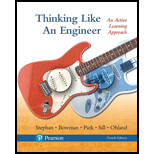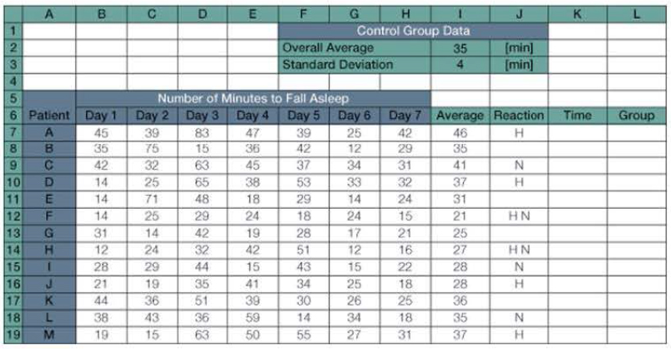
Concept explainers
A bioengineer conducts clinical trials on stressed-out college students to see if a sleep aid will help them fall asleep faster. She begins the study by having 20 students take a sleep aid for seven days and records through biofeedback the time when they fall asleep. To analyze the data, she sets up the following worksheet. Evaluate the expressions that follow; state what will appear in the cell when the command is executed. Column I contains the average time each student took to fall asleep during the seven-day trial. Column J contains any adverse reactions the students experienced (H = headache; N = nausea).
- a. Column K will contain the rating of the time it took the student to fall asleep compared with the control group, who did not take the medication. The statement as it appears in cell K14 is given below. What will appear in cell K14 when this statement is executed?
=IF> (I14>$I$2 + $I$3, ”MORE”, IF (I14 < $I$2 – $I$3, “LESS”,” ”))
- b. Column L groups the participants into three groups according to their reaction to the drug and the time it took them to fall asleep. Assume the statement for part (a) is executed in column K. The statement as it appears in cell L7 is given below. What will appear in cell L7 when this statement is executed?
=IF (AND(K7=”MORE”,J7=”H”), ”'MH”,
IF(AND(K7=”MORE” ,J7=”N”), ”MN”,””)
------
- c. Suppose the formula in column L was changed to regroup the participants. The statement as it appears in cell L9 is given below. In Excel, this statement would appear as a continuous line, but because of space restrictions it is shown here on two lines. What will appear in cell L9 when this statement is executed?
=IF (AND (K7=“MORE” ,OR(J9=“H”, J9=“'N”)), “SEVERE”,
IF (OR (J9=“'H”, J9=“'N”), “'MILD”, IF (K9=“'LESS”,“HELPFUL”,“”))
- d. Suppose the formula in part (c) was copied into cell L 16. What will appear in cell L16 when this statement is executed?
- e.
 Suppose the formula in part (c) was copied into cell L 18. What will appear in cell L18 when this statement is executed?
Suppose the formula in part (c) was copied into cell L 18. What will appear in cell L18 when this statement is executed?
Want to see the full answer?
Check out a sample textbook solution
Chapter 10 Solutions
Thinking Like an Engineer: An Active Learning Approach (4th Edition)
Additional Engineering Textbook Solutions
Fluid Mechanics: Fundamentals and Applications
Concepts Of Programming Languages
Thermodynamics: An Engineering Approach
BASIC BIOMECHANICS
Modern Database Management
Vector Mechanics for Engineers: Statics and Dynamics
- Please also draw the FBDsarrow_forwardDesign Description: Fresh water tank, immersed in an oil tank.a) Water tank:a. Shape: Cylindricalb. Radius: 1 meterc. Height: 3 metersd. Bottom airlock: 0.2m x 0.2m. b) Oil tank:a. Shape: cylindricalb. Radius: 4 metersc. Oil density: 850 kg/m³ Determine:a) The pressure experienced by an airlock at the bottom of the tank with water.b) The force and direction necessary to open the lock, suppose the lock weighs 20 Newtons, suppose the lock opens outwards. The image is for illustrative purposes, the immersed cylinder does not reach the bottomarrow_forwardNeed help!arrow_forward
- need help understanding?arrow_forward%94 KB/S Find : 1. dynamic load on each bearing due to the out-of-balance couple; and 2. kinetic energy of the complete assembly. [Ans. 6.12 kg: 8.7 N-m] L 2. 3. 4. 5. 1. 2. 5. DO YOU KNOW? Why is balancing of rotating parts necessary for high speed engines? Explain clearly the terms "static balancing' and 'dynamic balancing'. State the necessary conditions to achieve them. Discuss how a single revolving mass is balanced by two masses revolving in different planes. Chapter 21: Balancing of Rotating Masses .857 Explain the method of balancing of different masses revolving in the same plane. How the different masses rotating in different planes are balanced? OBJECTIVE TYPE QUESTIONS The balancing of rotating and reciprocating parts of an engine is necessary when it runs at (a) slow speed (b) medium speed (c) high speed A disturbing mass, attached to a rotating shaft may be balanced by a single mass m, attached in the same plane of rotation as that of my such that (a) (b) F For static…arrow_forwardProvide a real-world usage example of the following: Straightness Circularity Parallelism What specific tools, jigs, and other devices are used to control the examples you provided?arrow_forward
- 856 Theory of Machines 5. A shaft carries five masses A, B, C, D and E which revolve at the same radius in planes which are equidistant from one another. The magnitude of the masses in planes A, C and D are 50 kg, 40 kg and 80 kg respectively. The angle between A and C is 90° and that between C and D is 135° Determine the magnitude of the masses in planes B and E and their positions to put the shaft in complete rotating balance. [Ans. 12 kg, 15 kg; 130° and 24° from mass A in anticlockwise direction]arrow_forward2. 3. 4. clockwise from Four masses A, B, C and D revolve at equal radii and are equally spaced along a shaft. The mass B is 7 kg and the radii of C and D make angles of 90° and 240° respectively with the radius of B. Find the magnitude of the masses A, C and D and the angular position of A so that the system may be completely balanced. [Ans. 5 kg: 6 kg; 4.67 kg; 205° from mass B in anticlockwise direction] A rotating shaft carries four masses A, B, C and D which are radially attached to it. The mass centres are 30 mm, 38 mm, 40 mm and 35 mm respectively from the axis of rotation. The masses A, C and D are 7.5 kg. 5 kg and 4 kg respectively. The axial distances between the planes of rotation of A and B is 400 mm and between B and C is 500 mm. The masses A and C are at right angles to each other. Find for a complete balance, 1. the angles between the masses B and D from mass A, 2. the axial distance between the planes of rotation of C and D. 3. the magnitude of mass B. [Ans. 162.5%,…arrow_forward1. Four masses A, B, C and D are attached to a shaft and revolve in the same plane. The masses are 12 kg. 10 kg. 18 kg and 15 kg respectively and their radii of rotations are 40 mm, 50 mm, 60 mm and 30 mm. The angular position of the masses B, C and D are 60°, 135° and 270 from the mass A. Find the magnitude and position of the balancing mass at a radius of 100 mm. [Ans. 7.56 kg: 87 clockwise from A]arrow_forward
 Principles of Heat Transfer (Activate Learning wi...Mechanical EngineeringISBN:9781305387102Author:Kreith, Frank; Manglik, Raj M.Publisher:Cengage Learning
Principles of Heat Transfer (Activate Learning wi...Mechanical EngineeringISBN:9781305387102Author:Kreith, Frank; Manglik, Raj M.Publisher:Cengage Learning
